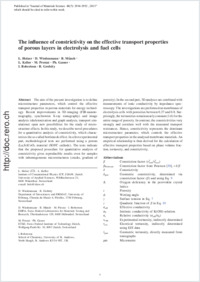The influence of constrictivity on the effective transport properties of porous layers in electrolysis and fuel cells
- Holzer, L. Institute of Computational Physics ICP, ZHAW, Zurich University of Applied Sciences, Winterthur, Switzerland
- Wiedenmann, Daniel Department of Geosciences and FRIMAT, University of Fribourg, Switzerland - EMPA, Swiss Federal Laboratories for Materials Testing and Research, Dübendorf, Switzerland
- Münch, B. EMPA, Swiss Federal Laboratories for Materials Testing and Research, Dübendorf, Switzerland
- Keller, L. Institute of Computational Physics ICP, ZHAW, Zurich University of Applied Sciences, Winterthur, Switzerland
- Prestat, M. EMPA, Swiss Federal Laboratories for Materials Testing and Research, Dübendorf, Switzerland - ETHZ, Swiss Federal Institute of Technology Zürich, Switzerland
- Gasser, Ph. ETHZ, Swiss Federal Institute of Technology Zürich, Switzerland
- Robertson, I. EMPA, Swiss Federal Laboratories for Materials Testing and Research, Dübendorf, Switzerland - School of Chemistry, University of St. Andrews, North Haugh, St. Andrews, UK
- Grobéty, Bernard Department of Geosciences and FRIMAT, University of Fribourg, Switzerland
-
01.04.2013
Published in:
- Journal of Materials Science. - 2013, vol. 48, no. 7, p. 2934-2952
English
The aim of the present investigation is to define microstructure parameters, which control the effective transport properties in porous materials for energy technology. Recent improvements in 3D-imaging (FIB-nanotomography, synchrotron X-ray tomography) and image analysis (skeletonization and graph analysis, transport simulations) open new possibilities for the study of microstructure effects. In this study, we describe novel procedures for a quantitative analysis of constrictivity, which characterizes the so-called bottleneck effect. In a first experimental part, methodological tests are performed using a porous (La,Sr)CoO₃ material (SOFC cathode). The tests indicate that the proposed procedure for quantitative analysis of constrictivity gives reproducible results even for samples with inhomogeneous microstructures (cracks, gradient of porosity). In the second part, 3D analyses are combined with measurements of ionic conductivity by impedance spectroscopy. The investigations are preformed on membranes of electrolysis cells with porosities between 0.27 and 0.8. Surprisingly, the tortuosities remain nearly constant (1.6) for the entire range of porosity. In contrast, the constrictivities vary strongly and correlate well with the measured transport resistances. Hence, constrictivity represents the dominant microstructure parameter, which controls the effective transport properties in the analysed membrane materials. An empirical relationship is then derived for the calculation of effective transport properties based on phase volume fraction, tortuosity, and constrictivity.
- Faculty
- Faculté des sciences et de médecine
- Department
- Département de Géosciences
- Language
-
- English
- Classification
- Physics
- License
- License undefined
- Identifiers
-
- RERO DOC 31951
- DOI 10.1007/s10853-012-6968-z
- Persistent URL
- https://folia.unifr.ch/unifr/documents/302968
Statistics
Document views: 67
File downloads:
- gro_ice.pdf: 216
